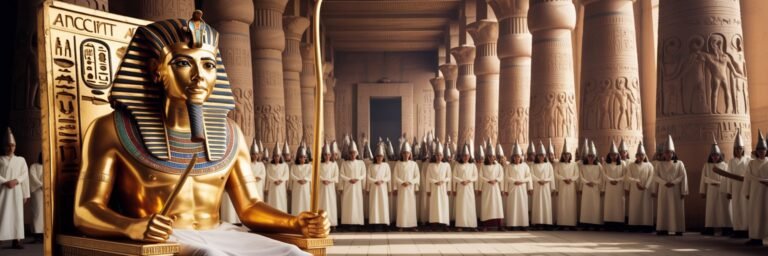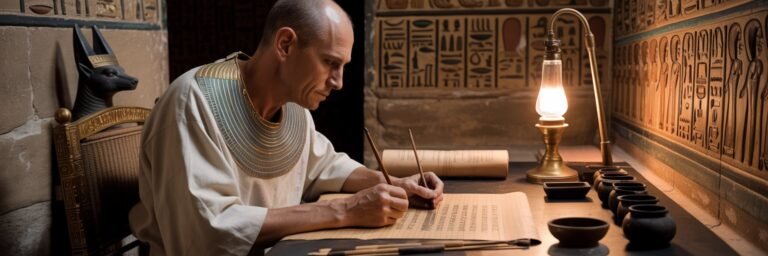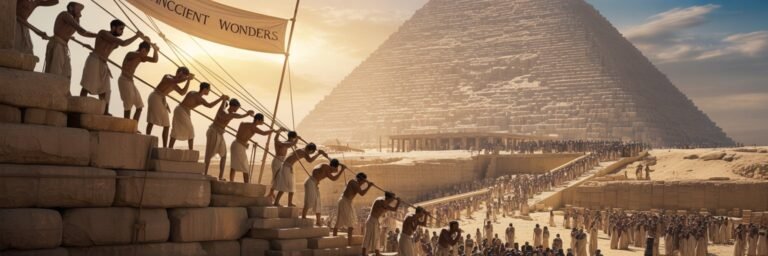INTRODUCTION
Winding time’s mantle back some 5000 years, we arrive at a civilization whose influence has not only pervaded history but continues to intrigue scholars today. The Sphinx’s shadow over the sparkling Nile, the cryptic hieroglyphics etched into ancient obelisks, the echoes of ancient rituals in delta’s whispers – all paint a vivid picture of everyday life in Ancient Egypt. This article shall serve as your time vessel, taking you through the Nile Valley, exploring the mystifying world of this ancient civilization. Embark on an enlightening journey across millennia, decoding their everyday life, social structure, religious beliefs, and symbolic illustrations that influenced their culture, along with unearthing some controversies and mysteries.
HISTORICAL BACKGROUND
Ancient Egypt, spanning from 3100 BC to 332 BC, was an era marked by unparalleled cultural zenith, sophisticated societal systems, and magnificent architectural marvels. The civilization was divided into three significant periods: the Old Kingdom (2700-2200 BC), known for its pyramid constructions, the Middle Kingdom (2050-1800 BC), the classic age of art and literature, and the New Kingdom (1550-1100 BC), characterized by territorial expansion and prosperous reign.
Egyptians’ everyday life was closely tied to the Nile, their indelible source of sustenance. Its annual floods, providing a fertile breeding ground for agriculture, dictated the rhythm of life, along with a solar calendar that meticulously marked religious and civil events. The hierarchical pyramid of society had the Pharaoh at its apex, followed by nobles, priests, soldiers, farmers, and slaves.
THEORIES AND INTERPRETATIONS
Scholarly interpretations of daily life in ancient Egypt range from viewing it as a theocratic, sophisticated civilization to a strict, authoritarian society. Historian Toby Wilkinson argues that the Pharaoh’s divine status was cultivated to maintain social control. In contrast, others, like French Egyptologist Françoise Dunand, accentuate the importance of community, familial relations and vivid cultural life beyond the Pharaoh’s shadow.
Women in ancient Egypt held unique status, often more elevated than their contemporaries in other societies. Legal and economic equalities were customary, and women could even ascend to the throne, with Cleopatra VII being the most notable. The family was the primary social unit, and concepts of affection and companionship were not dissimilar from today’s understanding.
MYSTERIES AND CONTROVERSIES
Despite thorough archaeological efforts, ancient Egypt remains enshrined in many mysteries and controversies. The method of pyramid construction, the cause of the Old Kingdom’s decline, the disappearance of Queen Nefertiti, and the controversy surrounding the cause of Tutankhamun’s death are among the hot debates among Egyptologists.
The Heretic Pharaoh Akhenaten’s decision to depart from traditional polytheistic worship and adopt monotheism centered around the Sun-disk Aten also sparks heated discussions among historians. It is a compelling instance to challenge the generalized belief of an unaltered continuance of traditions in ancient Egypt.
SYMBOLISM AND CULTURAL SIGNIFICANCE
Symbols and folklore were the cornerstone of ancient Egypt’s cultural identity. With more than 700 hieroglyphs, Egyptian writing was a complex combination of ideograms, phonetics, and semantic signs. Symbols such as the Eye of Horus (signifying protection and health), the Ankh (representing life), and the Scarab (symbolizing rebirth) embroidered a vibrant cultural tapestry.
Religion was fundamental in ancient Egyptian society, filled with a multitude of gods, each representing aspects of life like sun, earth, fertility, and death. Rituals, offerings, and monumental temples were manifestations of their religious fervor.
MODERN INVESTIGATIONS
Modern archaeological and academic pursuits continue to delve into the wonder called ancient Egypt. From remote sensing technology used in pyramid exploration to DNA studies unraveling familial links among royal mummies, scientific tools have revolutionized our understanding of this ancient civilization. The groundbreaking discovery of hidden chambers in Tutankhamun’s tomb by a team led by Archaeologist Mamdouh Eldamaty has astounded scholars worldwide.
Yet, it is essential to state that while technology aids in decoding history, it is the assiduous excavation of social, economic, and cultural aspects of life by historians, Egyptologists, and anthropologists that truly enlighten us about the enigmatic everyday life of ancient Egypt.
LEGACY AND CONCLUSION
Ancient Egypt, with its unique blend of indomitable river, fertile floodplains, imposing monuments, and cryptic symbolism, has left a lasting legacy. It has significantly influenced modern architecture, literature, spirituality, and even popular culture. Egypt’s ancient soul continues to invite, enthrall, and intrigue students, historians, and ordinary observers alike.
As we sail back to our time, leaving behind the time-worn pyramids on the hazy horizon, it remains clear that the study of everyday life in ancient Egypt is not just about understanding the past; it’s about realizing that history is a rich tapestry woven with innumerable individual threads. It tells us that humans, irrespective of the epochs they lived in, always sought to understand their world, strived for a prosperous life, and ventured towards the eternal quest for immortality. The ancient Egyptians were indeed builders, not only of tombs and temples but also of a civilization that continues to echo through time. Their daily life, wrapped in mystique and draped in time, still breathes, teaching us, entreating us, and keeping us under its eternal spell.






